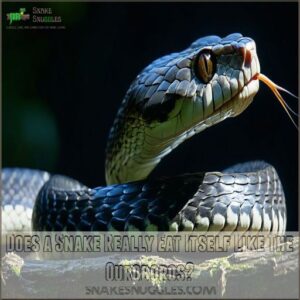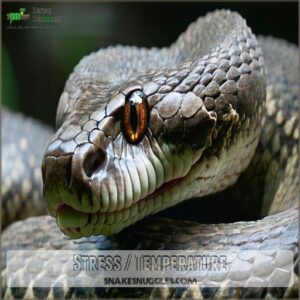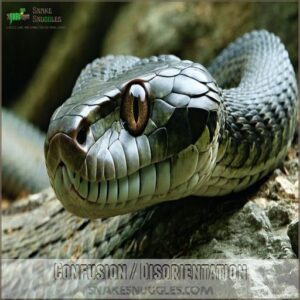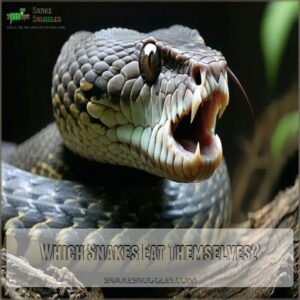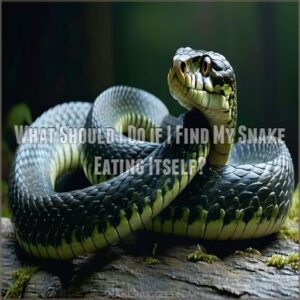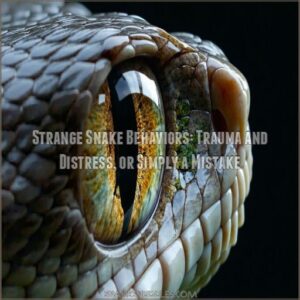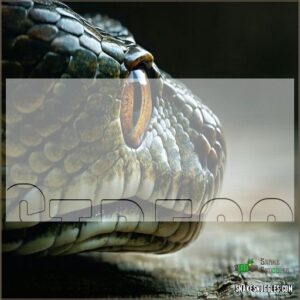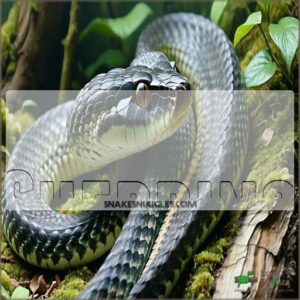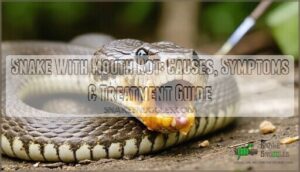This site is supported by our readers. We may earn a commission, at no cost to you, if you purchase through links.
 Ever wondered why a snake might chomp down on its own tail? It’s not a magic trick—it’s a cry for help!
Ever wondered why a snake might chomp down on its own tail? It’s not a magic trick—it’s a cry for help!
Snakes eat themselves due to stress, temperature problems, or confusion, especially in captivity.
Temperature swings, cramped spaces, and hunger can drive them to this bizarre behavior. Species like kingsnakes and ball pythons are more prone to self-cannibalism.
You’ll want to create a comfortable habitat with proper heat gradients, consistent feeding schedules, and minimal handling.
Watch for signs of distress like shedding difficulties or metabolic issues. If you catch your snake mid-bite, stay calm—there’s more to this slithery story than meets the eye.
Table Of Contents
- Key Takeaways
- Does a Snake Really Eat Itself Like The Ouroboros?
- Why Would a Snake Eat Its Own Tail?
- Which Snakes Eat Themselves?
- Can I Prevent My Snake From Ever Eating Its Own Tail?
- What Should I Do if I Find My Snake Eating Itself?
- Rooted in Myth: Ouroboros and Hoop Snakes
- Strange Snake Behaviors: Trauma and Distress, or Simply a Mistake
- What Happens When a Snake Eats Itself?
- Frequently Asked Questions (FAQs)
- Why does a snake eat itself?
- Why do snakes eat their own eggs?
- Why do wild snakes eat a lot?
- Do snakes eat their own body parts?
- Why do snakes try to swallow themselves?
- Do snakes eat themselves when they shed their skins?
- How Often Do Snakes Eat Themselves?
- Are There Any Medical Consequences of a Snake Eating Itself?
- Is There Any Way to Identify a Snake That is Likely to Eat Itself?
- Are There Any Snake Species That Are More Likely to Engage in Self-cannibalism?
- Conclusion
Key Takeaways
- You’ll want to create a stable habitat with consistent temperature gradients, as heat fluctuations can drive your snake to the dangerous behavior of self-cannibalism.
- Watch for signs of stress like irregular shedding, metabolic issues, and sensory confusion, which can trigger your snake to mistakenly bite its own tail.
- Maintain a balanced diet with regular feeding schedules and proper nutrition to prevent your snake from experiencing false hunger that might lead to self-destructive behaviors.
- If you catch your snake eating itself, stay calm and act quickly by cooling its environment, gently separating it from its tail, and seeking veterinary help within 24 hours to prevent serious injury.
Does a Snake Really Eat Itself Like The Ouroboros?
You might be surprised to learn that the ancient symbol of Ouroboros isn’t just a mythical concept – it’s occasionally a terrifying reality for some snakes.
While the legendary Ouroboros represents infinity and cyclical nature, real snake self-cannibalism is more complicated than the symbolic imagery suggests.
Rarely, but shockingly, some captive snakes can actually begin eating their own tail, turning the mythological representation into a disturbing biological phenomenon.
This isn’t a common occurrence, but it’s deeply rooted in cultural interpretations that span centuries.
The Ouroboros symbolism, once a philosophical representation of eternity, now provides a haunting parallel to the potential self-destructive behavior observed in certain snake species, including instances of trauma-induced self-biting.
Scientists continue to unravel the mysterious reasons behind this bizarre behavior, bridging ancient mythology with modern biological understanding.
Why Would a Snake Eat Its Own Tail?
Have you ever wondered why a snake might turn into its own worst enemy and start munching on its own tail?
In the wild world of reptiles, stress, metabolism, and sheer confusion can push a snake to the bizarre brink of self-cannibalism, turning its survival instinct into a startling act of self-destruction.
Stress / Temperature
When temperatures spike or plummet, your slithery friend might turn itself in a bizarre act of self-destruction. Temperature control isn’t just a luxury for pet snakes—it’s a matter of survival. Using a proper snake heat lamp can also play a vital role.
Here’s what can trigger snake self-cannibalism:
- Rapid heat fluctuations in the enclosure
- Improper thermal gradients from poorly placed heat lamps
- Stress and anxiety from poorly maintained environmental conditions
- Inadequate enclosure size limiting movement
- Disrupted natural thermoregulation patterns
Snake stress manifests in disturbing ways, with heat and anxiety transforming a docile reptile into a potential self-threat. By maintaining consistent temperature regulation and creating a stable habitat, you’ll dramatically reduce the risk of this disturbing behavior. Your snake depends on you to create a safe, comfortable environment that mimics its natural thermal landscape.
Metabolism / False Hunger
A metabolic meltdown can turn your snake’s survival instincts into a dangerous self-feeding frenzy. Hypermetabolism triggers false hunger cues, causing snakes to mistake their own tail for prey, especially when their digestive system goes haywire.
Overheating can supercharge a snake’s metabolic rate, pushing its predatory impulses into overdrive and blurring the lines between self-preservation and self-consumption.
Nutritional deficiencies compound the problem, creating a perfect storm of metabolic confusion that drives snakes to make the ultimate dietary mistake. Improper feeding frequency and unbalanced diets can send mixed signals to a snake’s brain, transforming hunger into a potentially fatal self-cannibalism scenario.
In addition, poor health conditions, such as respiratory infections, can also play a significant role in triggering this behavior.
Understanding these metabolic triggers is essential for preventing this shocking snake health issue.
Confusion / Disorientation
While false hunger might trigger self-eating, disorientation can push snakes into shocking self-harm.
Snakes being poikilotherms often struggle with thermoregulation issues.
Snake self-cannibalism often stems from complex sensory challenges:
- Vision impairment during shedding
- Enclosure stress disrupting spatial awareness
- Prey confusion from sensory overload
- Habitat instability triggering neurological misfires
These factors transform a snake’s natural instincts into a potentially deadly mistake.
Which Snakes Eat Themselves?
In the corners of reptile habitats, some snake species are more prone to the bizarre phenomenon of snake self-cannibalism. Species like kingsnakes, ball pythons, and certain smaller captive snakes exhibit a higher frequency of self-eating behaviors due to genetic and environmental factors. Captive environments dramatically increase the risk compared to wild habitats, where natural stimuli and space regulate snake behavior more effectively.
Dietary influences play a pivotal role in this shocking behavior. Snakes with irregular feeding schedules or nutritional deficiencies become more likely to mistake their own tail for prey. Venomous species possess a unique immunity that allows them to potentially bite themselves without immediate fatal consequences, though this doesn’t make the behavior safe. In certain cases, snakes may also exhibit self-cannibalism due to underlying health issues, such as vision problems or poor feeding habits.
North American folklore even spawned the mythical "hoop snake" – a creature rolling into a circle and biting its own tail out of frustration. While folklore exaggerates, the scientific reality of snake self-cannibalism remains equally fascinating and disturbing.
Understanding species susceptibility helps snake owners prevent this self-destructive behavior through proper care, consistent feeding, and attentive environmental management.
Can I Prevent My Snake From Ever Eating Its Own Tail?
After learning about which snake species might turn cannibalistic, prevention becomes your top priority.
Creating a snake-friendly habitat is key to stopping tail self-amputation. Design an enclosure that mimics their natural environment, complete with proper temperature gradients and hiding spots.
Stress reduction matters big time – keep temperatures stable, offer a balanced diet that meets their specific dietary needs, and provide habitat enrichment through carefully planned spaces.
Recognizing stress in snakes through signs such as changes in feeding behavior is key to preventing self-cannibalism when your snake is stressed.
Watch for signs of metabolic issues or vision problems that could lead to snake self-cannibalism.
Regular feeding schedules and consistent care can help your slithery friend stay calm and content.
By understanding your snake’s unique needs and maintaining a supportive environment, you’ll dramatically reduce the risk of this shocking behavior.
What Should I Do if I Find My Snake Eating Itself?
Something seems terribly wrong when you catch your snake mid-bite on its own tail. Immediate action is necessary to prevent serious injury and potential snake self-cannibalism.
Your first move should involve staying calm and acting quickly. Gently attempt to separate the snake from its tail, being extremely careful not to cause additional stress or damage. Here are critical steps to take:
- Cool the snake’s environment immediately to reduce metabolic stress
- Carefully extract the tail from the snake’s mouth using smooth, gentle motions
- Check for common snake health issues that may be triggering this behavior, such as dehydration, parasites, or skin infections
- Seek professional veterinary help within 24 hours of the incident
Preventing further self-harm requires a thorough investigation. Check your snake’s habitat for potential triggers like temperature fluctuations, inadequate lighting, or cramped conditions. Treating snake self-eating isn’t just about the moment—it’s about understanding underlying causes.
Veterinary professionals can help diagnose why your snake might be engaging in this dangerous behavior. They’ll assess potential issues like metabolism problems, vision impairments, or nutritional deficiencies that could trigger snake self-harm.
Post-incident care is critical. Monitor your snake closely, maintain a stable environment, and follow your vet’s recommendations to prevent recurrence of this alarming behavior.
Rooted in Myth: Ouroboros and Hoop Snakes
Ever wondered why ancient myths depict snakes eating themselves? The Ouroboros symbol isn’t just a wild tale—it’s a profound representation of life’s cyclical nature. Hoop snake legends and cultural interpretations reveal more than just biological curiosity.
- Ancient civilizations saw self-consuming snakes as cosmic metaphors
- Ouroboros symbolizes eternal renewal and interconnectedness
- Myths transform rare biological behaviors into philosophical insights
- Cultural perspectives transcend literal snake self-cannibalism
These mesmerizing legends bridge scientific observation with mystical understanding. From Egyptian tomb paintings to alchemical manuscripts, the image of a snake devouring its own tail represents more than just a bizarre behavior. It’s a powerful metaphor for transformation, showcasing how a single moment can embody destruction and creation—a reminder that sometimes, understanding goes far beyond what meets the eye.
Strange Snake Behaviors: Trauma and Distress, or Simply a Mistake
Under the surface of seemingly bizarre snake behaviors, a complex web of stress, trauma, and confusion often lurks. Your pet snake might appear to be acting out of pure instinct, but up to 98% of strange self-destructive behaviors stem from deeper psychological and physiological triggers.
Captive stress can transform a normally docile snake into a creature battling intense internal pressures. Vision issues during shedding create a disorienting landscape where the snake might mistake its own tail as potential prey. Imagine being trapped in an environment so confusing that your own body becomes unrecognizable – that’s the reality for many snakes experiencing behavioral quirks.
Snakes don’t just wake up deciding to eat themselves. Neurological malfunctions, compromised sensory perception, and limited cognitive processing can push these reptiles into shocking self-cannibalism. Their small brains prioritize immediate stimuli, leading to what looks like a desperate survival mechanism.
Environmental factors play a key role. Tight enclosures, irregular schedules, and constant handling can trigger displacement behaviors that manifest as snake self-harm. It’s like a pressure cooker of stress, with the snake’s instincts misfiring in the most extreme way possible.
Understanding these behavioral patterns isn’t just fascinating – it’s essential for responsible snake ownership and ensuring your scaly friend’s mental and physical well-being.
What Happens When a Snake Eats Itself?
Imagine a snake that starts munching on its own tail, a bizarre behavior that can lead to serious health risks.
You’ll want to understand why this happens and how to protect your scaly friend from this dangerous self-destructive habit.
Problems With Thermoregulation
When strange snake behaviors escalate from curiosity to self-destruction, temperature problems often lurk beneath the surface. Improper thermoregulation can be mitigated with the right snake thermostat equipment.
Improper thermoregulation can turn a snake’s habitat from a safe haven into a stress-inducing nightmare. Your reptilian friend relies on precise temperature gradients to maintain normal body functions – and when those gradients go haywire, trouble follows.
Snakes can’t regulate their body heat like mammals do. They depend on external sources like heating lamps and basking spots to stay balanced. Without these carefully managed thermal zones, a snake might become disoriented, confused, and potentially resort to the shocking behavior of eating itself.
Your snake’s tank needs dedicated warm and cool areas that mimic natural environments. Heating issues can trigger metabolic chaos, pushing your snake into survival mode where its own body becomes a potential meal. Regular temperature checks and professional veterinary guidance can prevent these dangerous self-cannibalism scenarios.
Hypermetabolism
Skyrocketing metabolism can transform your snake into a potential self-cannibal, triggered by extreme environmental conditions.
Hypermetabolism causes snakes to experience an abnormally high metabolic rate, pushing them toward desperate survival behaviors like eating their own tail.
Temperature extremes—whether scorching heat or sudden cold—can dramatically disrupt your snake’s internal systems, creating a perfect storm for self-destructive actions. Limited enclosure space compounds this risk, preventing proper body orientation and temperature regulation.
Treating hypermetabolism requires careful environmental management: provide consistent temperature gradients, verify adequate hiding spots, and monitor your snake’s living conditions closely.
Watch for signs of metabolic distress and act quickly to prevent potential self-cannibalism.
Stress
Here’s the focused piece on stress in snake self-cannibalism:
Hypermetabolism might spark internal chaos, but stress can push a snake over the edge into self-destructive behavior. Your scaly friend’s mental state matters more than you’d think.
Stress sources that trigger snake self-harm include:
- Cramped living spaces
- Frequent, rough handling
- Sudden environmental changes
- Lack of hiding spots
Captivity stress wreaks havoc on a snake’s psyche, making it feel trapped and vulnerable. When anxiety builds, these reptiles might literally turn on themselves. Handling stress becomes particularly dangerous, as snakes interpret touch as a potential threat. Creating a calm, enriching habitat with plenty of safe zones can dramatically reduce your snake’s anxiety and prevent this shocking self-cannibalism behavior.
Hunger
Stress can push a snake to the brink, but hunger becomes an even more dangerous predator.
Your snake’s appetite isn’t just about filling its belly—it’s a delicate balance that can trigger shocking self-destructive behaviors. Improper feeding schedules and nutritional deficiencies create a perfect storm for snake self-cannibalism.
When food becomes scarce, even the most docile reptile might mistake its own tail for a meal. Appetite loss signals serious trouble, urging snake owners to pay close attention to feeding routines.
A varied diet matching the snake’s specific nutritional needs prevents starvation risks. Smaller enclosures can amplify hunger-driven confusion, causing your snake to see its own body as potential prey.
Consistent, species-appropriate feeding is your best defense against this bizarre survival instinct.
Shedding
If hunger isn’t the culprit, shedding difficulties might trigger your snake’s bizarre self-consumption.
During incomplete sheds, snakes can become disoriented, mistaking their own body for prey. Retained shed skin creates visual confusion that leads to shed ingestion or even self-cannibalism.
Prevent these snake health issues by maintaining proper humidity, providing rough surfaces for shedding assistance, and monitoring your snake closely during vulnerable shedding periods.
A well-managed environment keeps your scaly friend from turning into its own meal ticket.
Frequently Asked Questions (FAQs)
Why does a snake eat itself?
When your slithery friend turns into a self-snacking nightmare, it’s often due to environmental stress,
hunger confusion,
or health issues that trick the snake into mistaking its own tail for a tasty meal.
Why do snakes eat their own eggs?
Snakes might munch on their own eggs due to nutritional deficiencies, overcrowding, or stress.
They’ll sometimes eat eggs to recoup energy, protect the nest from predators, or when environmental conditions become too challenging for successful reproduction.
Why do wild snakes eat a lot?
You’re hardwired to hunt constantly in the wild, burning through calories faster than city folks burn through coffee.
Your metabolism demands frequent meals to survive harsh environments and maintain energy for hunting and survival.
Do snakes eat their own body parts?
Imagine a snake turning on itself like a twisted pretzel.
Yes, some snakes can accidentally eat their own body parts due to stress, hunger, or confusion.
Often, this is triggered by poor habitat conditions or health issues.
Why do snakes try to swallow themselves?
When a snake’s stressed or confused, it might mistake its own tail for prey, leading to self-cannibalism.
Overheating, poor vision, and nutritional deficiencies can trigger this bizarre survival instinct gone wrong.
Do snakes eat themselves when they shed their skins?
Like a snake shedding its old jacket, you won’t see it munching on its skin.
Snakes typically don’t eat their shed because it’s just dry, lifeless tissue they’re leaving behind, not a tasty snack.
How Often Do Snakes Eat Themselves?
You’ll rarely see a healthy snake eat itself.
Most self-cannibalism cases happen in captivity due to stress, incorrect temperatures, or feeding issues.
Quick veterinary care can help prevent this dangerous behavior from becoming fatal.
Are There Any Medical Consequences of a Snake Eating Itself?
Self-cannibalism can seriously harm your snake, causing life-threatening blood loss, potential organ damage, and severe infections that might lead to death if not promptly treated by a reptile veterinarian.
Is There Any Way to Identify a Snake That is Likely to Eat Itself?
Watch for signs like constant agitation, irregular shedding, or nervous tail-tracking. Stressed snakes with poor habitat conditions or inconsistent feeding schedules are more prone to self-cannibalistic behaviors.
Are There Any Snake Species That Are More Likely to Engage in Self-cannibalism?
Kingsnakes and some tropical species are more prone to self-cannibalism.
Their intense feeding instincts and metabolic quirks make them particularly susceptible to this bizarre behavior.
Self-cannibalism is due to their predatory nature and heightened stress responses.
Conclusion
When push comes to shove, understanding why snakes eat themselves is vital for responsible reptile care.
You’ve learned that self-cannibalism isn’t a random act, but a signal of underlying issues.
By maintaining proper habitat conditions, monitoring stress levels, and addressing your snake’s physical and environmental needs, you can prevent this shocking behavior.
Remember, preventing this behavior requires vigilance, knowledge, and proactive care. Your snake’s health depends on your attentive management.

